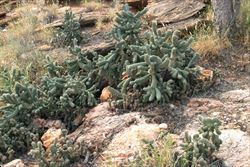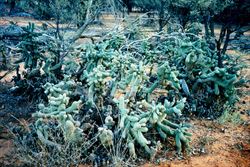Click on images to enlarge

infestation (Photo: David Albrecht)

infestation (Photo: Land Protection, QDNRW)

habit (Photo: Land Protection, QDNRW)

habit (Photo: Land Protection, QDNRW)

spiny stem segments (Photo: Land Protection, QDNRW)

spiny stem segments (Photo: Sheldon Navie)
Scientific Name
Cylindropuntia fulgida (Engelm.) F.M. Knuth var. mamillata (Engelm.) Backeb.
Synonyms
Cylindropuntia fulgida (Engelm.) F.M. KnuthCylindropuntia fulgida (Engelm.) F.M. Knuth forma monstruosa P.V. Heath.Cylindropuntia fulgida (Engelm.) F.M. Knuth var. mamillata (Schott ex Engelm.) Backeb. forma monstruosa P.V. Heath.Opuntia fulgida Engelm.Opuntia fulgida Engelm. var. mamillata (Schott ex Engelm.) J.M. CoulterOpuntia mamillata Schott ex Engelm.
Family
Cactaceae
Common Names
boxing glove cactus, boxing-glove cactus, boxing glove cholla, club cactus, coral cactus, jumping cactus, jumping cholla, Sonoran jumping cholla
Origin
Native to south-western USA (i.e. Arizona) and northern Mexico.
Naturalised Distribution
This species is naturalised mainly in the drier inland regions of Australia. It has been recorded mainly in the western parts of New South Wales and Queensland, but is also occasionally naturalised in Western Australia and South Australia. Possibly also naturalised in the southern parts of Northern Territory.
Note: All naturalised populations in Australia are of the distorted (i.e. cristate) form known as Cylindropuntia fulgida var. mamillata forma monstruosa, which does not produce flowers or fruit.
Legislation
Queensland: Class 2 - landowners must take all reasonable steps to keep land free of this species (throughout the entire state). It is also illegal to keep or sell a Class 2 plant without a permit.
Notes
Boxing glove cactus (Cylindropuntia fulgida var. mamillata) is regarded as an environmental weed or potential environmental weed in parts of New South Wales, Western Australia and Queensland.
At present it is not common or widespread, but over the last few years populations in New South Wales have rapidly increased in density and area. It is now locally common in and around the mining settlements of Broken Hill, Cumborah, Grawin and Lightning Ridge in New South Wales. If allowed to spread, it could replace more useful species and affect the pastoral value and natural biodiversity of semi-arid plant communities. It is also thought to have the potential to become a widespread and abundant pest throughout south-western Queensland.

